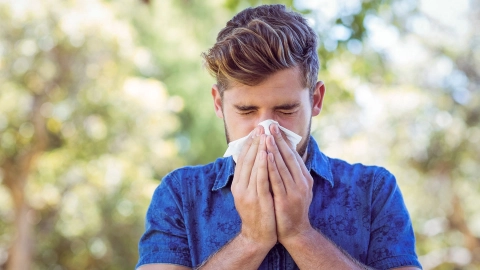Conditions Allergies
ICD codes: T78.4 What are ICD codes?
An allergy occurs when the body’s immune system has an overly sensitive reaction to a foreign substance that is actually harmless. Allergy triggers include plant pollen or certain types of food. There are various ways to treat allergies.
At a glance
- An allergy occurs when foreign substances (allergens) that are actually harmless trigger an excessively sensitive reaction in the immune system.
- An allergic reaction most frequently affects the airways, skin, and mucous membranes.
- The tendency towards allergies is often inherited.
- Sufferers can sidestep some allergy triggers, but other allergens are almost impossible to avoid.
- In Germany, approximately one third of the population has an allergy.
Note: The information in this article cannot and should not replace a medical consultation and must not be used for self-diagnosis or treatment.

What is an allergy?
An allergy occurs when foreign substances (allergens) that are actually harmless trigger an excessively sensitive reaction in the body’s immune system. Allergy triggers include plant pollen and certain types of food.
Allergy symptoms vary widely between individuals. In some cases, they are mild. In others, however, they can be very distressing and have a significant impact on quality of life. A severe allergic reaction can even be life-threatening.
Various treatment options are available for allergies. Sufferers can sidestep some triggers, but other substances are almost impossible to avoid. Typical substances that can trigger an allergy include:
- pollen
- house dust mites
- pets and farm animals
- insect stings
- foods
- medication
- contact allergens (e.g. metals or perfumes)
- mold
Important: Allergies are sometimes referred to as “hypersensitivities”. However, hypersensitivities that are not allergies can also occur. These include, for example, certain food intolerances, such as lactose intolerance and celiac disease. In some cases, the symptoms of an allergy and a hypersensitivity may be similar. It is therefore important to have symptoms investigated in a thorough medical examination. If the symptoms are triggered by an allergic reaction, the appropriate treatment options can be chosen.
What are the signs of an allergy?
The typical symptoms of an allergic reaction are:
- rhinitis (sneezing, itchiness and a blocked or runny nose)
- coughing
- sneezing
- breathing difficulties
- watering eyes
- itching
- skin rashes
- swelling in the mucous membranes
- gastrointestinal problems

Usually, the allergic reaction occurs in the part of the body that has had direct contact with the triggering substance (allergen).
Further information about individual allergies is provided on the gesundheitsinformation.de website:
food allergy
contact allergy
medication allergy
hay fever
insect venom allergy
What causes an allergy?
Several factors increase the risk of an allergy.
The tendency towards allergies is often genetically determined. Experts refer to this inherited tendency as “atopy”. Various environmental factors determine whether this genetic predisposition will actually cause an allergy to develop. These include, for example, exposure to air pollution or cigarette smoke. Such factors increase the likelihood of allergies and complications such as asthma.
House dust mites or food are not normally harmful to the body. In individuals with allergies, however, they trigger symptoms.
The reason for this is that, when an allergic reaction occurs, the body’s immune system responds to certain foreign proteins (allergens) that are actually harmless in the same way that it would react to a disease-causing germ or other invading organism. The immune system identifies the allergens as harmful and attempts to fight them off. To do so, it creates antibodies, specifically IgE antibodies.
Video What is an allergy?
The video below explains what can trigger an allergy and what symptoms can occur.
This and other videos can also be found on YouTube
Watch nowThe privacy policy indicated there applies.
How common are allergies?
In Germany, approximately one third of the population will be diagnosed with an allergy at some stage of their lives. Around 20 to 25 percent of all children and adolescents have hay fever, asthma, or neurodermatitis. The number of people diagnosed with allergies has risen over the past 30 years.
How do allergies develop?
Most allergies begin during childhood or adolescence and often last a lifetime. However, some allergies may improve during adulthood.
Certain food allergies, such as allergies to milk or chicken eggs, may even disappear – although peanut allergies do not normally resolve. In other words, the allergen determines the progression of the allergy.
When an allergy initially develops, the symptoms are often mild. However, they tend to worsen over time and may also cause other health complications. For example, if a person suffers from hay fever for many years, an “allergic march” (also called “atopic march”) may occur.
This term describes the progression of the allergy, whereby the symptoms also begin to affect the lower airways, causing asthma. Individuals with allergies are also more likely to have neurodermatitis.
Important: As different allergens contain similar proteins, some substances may cause cross-sensitivity. For example, a pollen allergy may be associated with an allergy to a specific food.
What can be done to prevent an allergy?
In many cases, allergies cannot be prevented. However, certain measures can be taken that may reduce the risk to a certain extent. Children who are exclusively breast-fed during their first six months of life are less likely to develop allergic asthma. However, studies indicate that this factor has little to no influence in the case of other symptoms such as allergic rhinitis.
Cigarette smoke increases the risk of allergies. Therefore, non-smokers and children raised in a smoke-free environment are less likely to have allergies.
People who are at high risk of developing allergies should think twice about having a cat in their home in order to avoid a cat allergy. However, there is no need to avoid pets if the risk of developing an allergy is not elevated.
How is an allergy diagnosed?
After the initial consultation to clarify symptoms, living conditions, and medical history, the doctor can conduct specific allergy tests. The tests are offered by doctors specializing in allergology – usually dermatologists, ENT consultants, lung specialists, or pediatricians.
A skin prick test is used to detect whether an individual has an allergic reaction to specific substances.
An epicutaneous test, commonly known as a patch test, is suitable for detecting suspected allergies where the symptoms do not occur until 12 hours to three days after contact with the trigger. The suspected allergens are applied to a patch, which is then placed on the back or forearm. If the person has an allergy, the skin will react with redness, swelling, and itching.
A blood test for antibodies or a provocation test may also be necessary. In a provocation test, the patient is exposed to various allergens to determine whether a reaction occurs.
For more detailed information about allergies and allergy testing, see gesundheitsinformation.de.
How is an allergy treated?
One approach is to avoid contact with allergens. However, the success of this approach depends on the trigger itself. Certain foods or chemical substances can often be successfully avoided – however, there is virtually no way for sufferers to shield themselves entirely from pollen. For those allergic to dust mites, the amount of dust they are exposed to in the home can at least be somewhat reduced.
Medication such as antihistamines or cortisone treatments are often used to treat allergic rhinitis and allergic conjunctivitis in particular. These are available as tablets, nasal sprays, or shots, for example. Cortisone ointments and creams are also used to treat allergic skin reactions.
Desensitization (also known as allergen-specific immunotherapy) may help people with certain allergies to become less sensitive to the allergen in the long term. As with a vaccination, patients undergoing this treatment receive regular low doses of the allergen either injected into the skin or administered as drops under the tongue. Desensitization is largely used for allergies to pollen, dust mites, and insect stings. It lasts for at least 3 to 5 years.
There is as yet no evidence to prove that plant-based or homeopathic treatments or acupuncture help relieve allergies.
What else should I know?
Details of severe allergies that entail the risk of a life-threatening anaphylactic reaction can be stored in the emergency data record on the electronic medical data card.
For further information about anaphylactic reactions, visit gesundheitsinformation.de.
Current research is increasingly focusing on the interaction between the immune system and environmental influences. The results of this research will be used to formulate new methods for preventing and treating allergies.
For more detailed information about allergies and research, visit allergieinformationsdienst.de.
- Biedermann T, Heppt W, Renz H, Röcken M (Ed). Allergologie. Berlin: Springer; 2016.
- Deutsche Gesellschaft für Allergologie und klinische Immunologie (DGAKI). Allergieprävention (S3-Leitlinie). AWMF-Registernr.: 061-016. 2021. Aufgerufen am 17.10.2024.
- Güngör D, Nadaud P, LaPergola CC et al. Infant milk-feeding practices and food allergies, allergic rhinitis, atopic dermatitis, and asthma throughout the life span: a systematic review. Am J Clin Nutr 2019; 109 (Suppl 7): 772S-799S. Aufgerufen am 17.10.2024.
- Robert Koch-Institut (RKI). Allergische Erkrankungen bei Kindern und Jugendlichen in Deutschland – Querschnittergebnisse aus KiGGS Welle 2 und Trends. Journal of Health Monitoring 2018; 3(3): 3-18. Aufgerufen am 17.10.2024.
- Trautmann A, Kleine-Tebbe J. Allergologie in Klinik und Praxis. Stuttgart: Thieme; 2022.
- World Allergy Organization (WAO). White Book on Allergy. Update 2013. WAO: Milwaukee: WAO; 2013. Aufgerufen am 17.10.2024.
Zhang X, Lan F, Zhang Y et al. Chinese Herbal Medicine to Treat Allergic Rhinitis: Evidence From a Meta-Analysis. Allergy Asthma Immunol Res 2018; 10(1): 34-42. Aufgerufen am 17.10.2024.
In cooperation with the Institute for Quality and Efficiency in Health Care (Institut für Qualität und Wirtschaftlichkeit im Gesundheitswesen – IQWiG).
As at:






